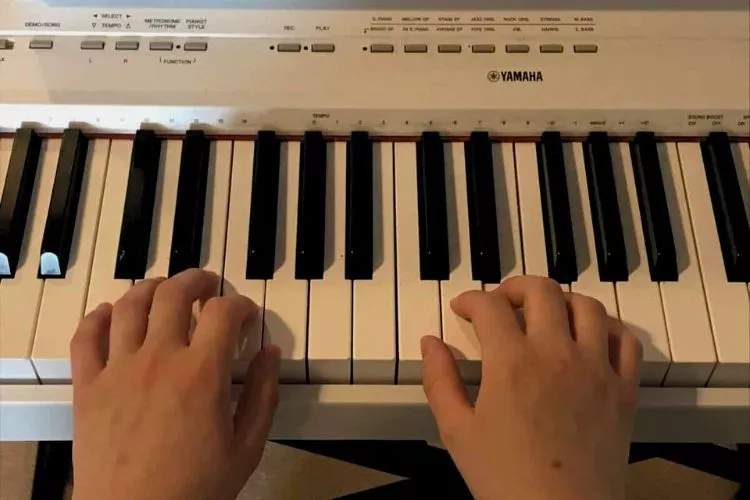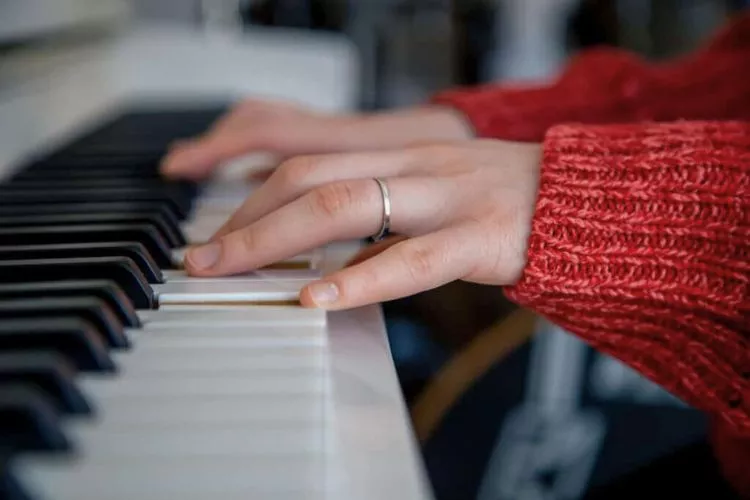Finger agility is one of the most important skills for piano players. It involves the ability to move fingers quickly and precisely while playing complex passages.
Developing finger agility can greatly enhance your overall playing technique and help you tackle challenging pieces with ease. Here’s how to improve finger agility for piano.

In this article, we will explore various tips, techniques, and exercises to help you improve your finger agility for piano playing.
Contents
- 1 How to Improve Finger Agility for Piano Playing?
- 2 🎶Warm-up Exercises for Finger Agility
- 3 🎶Improving Finger Agility for Piano Playing
- 3.1 1. Hanon Exercises
- 3.2 2. Octave Jumps
- 3.3 3. Chromatic Scales
- 3.4 4. Trills
- 3.5 5. Lateral Finger Motion
- 3.6 6. Slow Practice
- 3.7 7. Burst vs. Endurance
- 3.8 8. Two-Handed Exercises
- 3.9 9. Playing Different Genres
- 3.10 10. Hand and Finger Exercises
- 3.11 11. Listen to Your Body
- 3.12 12. Practice With a Metronome
- 3.13 13. Tools and Resources for Improving Finger Agility
- 3.14 14. Overcoming Challenges
How to Improve Finger Agility for Piano Playing?
Before we delve deep here’s a overview. Improving finger agility for piano playing can be achieved with these methods:
- Scales and Arpeggios: Regularly practice major and minor scales and arpeggios, focusing on maintaining even tone and tempo.
- Etudes: Use Etudes or “study pieces” designed for technical development. Composers like Czerny, Hanon, or Chopin have suitable compositions.
- Slow Practice: Start practicing pieces slowly, focusing on accuracy over speed. Gradually increase the tempo over time.
- Finger Independence Exercises: Practice exercises that promote finger independence, such as playing one finger at a time while keeping others on the keys.
- Stretches and Strength Training: Regular hand and finger stretches prevent injury; strength training exercises, like pressing firm surfaces in various hand position, can help.
- Regular Breaks: Take brief breaks during practice sessions to avoid straining the fingers, and always stop if you feel pain.
- Professional Guidance: If feasible, seeking guidance from a trained piano teacher can provide tailored methods to improve agility.
🎶Warm-up Exercises for Finger Agility
Before diving into exercises for improving finger agility, it’s important to warm up your hands and fingers. Start with a few basic finger stretches to help loosen up your muscles. Extend each finger one at a time and hold for a few seconds.

Next, incorporate finger taps into your warm-up routine. Start by tapping each finger on the piano keys, gradually increasing the speed and intensity. Then move on to using two fingers, alternating between them at a rapid pace.
Another useful warm-up exercise is practicing scales and arpeggios. These exercises can help you develop finger control and familiarize yourself with the keyboard.
🎶Improving Finger Agility for Piano Playing

1. Hanon Exercises
Hanon exercises are a popular series of finger agility exercises that have been used for over a century. They consist of a series of repetitive patterns that target various finger combinations and muscle groups.
Hanon exercises can be found in many piano exercise books, and they are designed to improve finger strength, control, and agility.
2. Octave Jumps
Octave jumps are an excellent exercise for improving finger agility and coordination. Start by playing an octave interval, jumping between the thumb and pinky finger.
Gradually increase the speed of the interval and switch between different octaves and hand positions. This exercise can help you develop finger independence and precision.
3. Chromatic Scales
Chromatic scales involve playing all the notes of the piano in a consecutive sequence, moving up and down the keyboard.
This exercise can help you develop finger speed and dexterity. Focus on playing each note cleanly and evenly, and gradually increase the speed of the scale.
4. Trills
Trills involve alternating rapidly between two adjacent notes with the same finger. This exercise can help you improve finger control and agility. Start by practicing trills with your index finger and gradually incorporate other fingers.
5. Lateral Finger Motion
Lateral finger exercises involve moving your fingers laterally across the keyboard. Start by placing your fingers on a set of keys and moving them laterally to the adjacent set of keys. This exercise can help you develop finger agility and independence.
Certainly! Here are some additional tips and techniques that can help you improve your finger agility for piano playing.
6. Slow Practice
While it may seem counterintuitive, practicing slowly can actually help you improve your finger agility over time. Playing slowly allows you to focus more on each note and every movement of your fingers.
This concentration improves your accuracy and control, which are essential for developing finger agility. Gradually increase the speed of the piece as you become more comfortable with the passages.
7. Burst vs. Endurance
Two different types of practice methods can help improve finger agility: burst and endurance. Burst practice involves playing short passages at a high speed, then taking a break and repeating the process.
Endurance practice involves playing for a longer duration without any breaks. Both methods will help you develop your finger agility, so it is important to balance them in your practice routine.
8. Two-Handed Exercises
Two-handed exercises can help you develop finger coordination and independence in both hands.
Start with simple exercises like playing the same note with both hands and progress to more complex patterns. You can also try playing different rhythms with each hand to challenge your coordination.
9. Playing Different Genres
Playing different genres of music can also help improve your finger agility. Each genre requires different technical skills and finger movements, meaning that exploring different genres can help you improve your range of movements and dexterity.
From classical to jazz to pop music, each genre of music offers different techniques and challenges.
10. Hand and Finger Exercises
Perform various hand and finger exercises that specifically focus on building finger agility, strength, and dexterity.
Incorporate finger push-ups, finger extensions, and grip recoveries in your practice routine. These exercises can also help prevent injury and reduce muscle tension.
11. Listen to Your Body
As you are practicing finger agility exercises, it is important to listen to your body and take breaks when necessary.
Pushing your fingers too far and too fast can lead to injuries or pain, which can hinder your progress. Being patient and trusting the process is crucial in the long-term development of finger agility.
12. Practice With a Metronome
A metronome is a valuable tool for improving finger agility as it helps you maintain a consistent tempo. Start by selecting a comfortable tempo for a particular piece or exercise, and gradually increase the speed as you become more comfortable.
Once you are comfortable with a particular speed, increase the tempo further and keep pushing yourself to play faster.
13. Tools and Resources for Improving Finger Agility
There are many tools and resources available to help you improve your finger agility for piano playing. Online tutorials, piano exercise books, and piano apps can be valuable resources for targeted finger agility exercises.
Additionally, working with a piano teacher or mentor can provide personalized feedback and identify areas for improvement.
14. Overcoming Challenges
Improving finger agility can be a challenging process. It requires consistent practice and patience to develop the necessary skills.
Overcoming the initial frustration that comes with developing finger agility can be achieved by breaking down the process into small steps and rehearsing on a regular basis. Avoid overworking your fingers as hurrying the progress may cause strains or other injuries.
Incorporate finger agility exercises into your regular practice routine, and gradually increase the duration and intensity of your practice sessions. Celebrate your progress as you reach new milestones in your finger agility development.
You may also find useful: How to Practice Sight Reading for Piano?
Conclusion:
In conclusion, improving finger agility is a crucial skill for piano playing. By following the tips, techniques, and exercises outlined in this article, you can gradually build your finger agility and enhance your overall piano playing technique.
Remember that consistency, patience, and a gradual approach are key to developing finger agility effectively.
With dedicated practice and persistence, you can achieve greater finger agility and unlock new possibilities in your piano playing.
